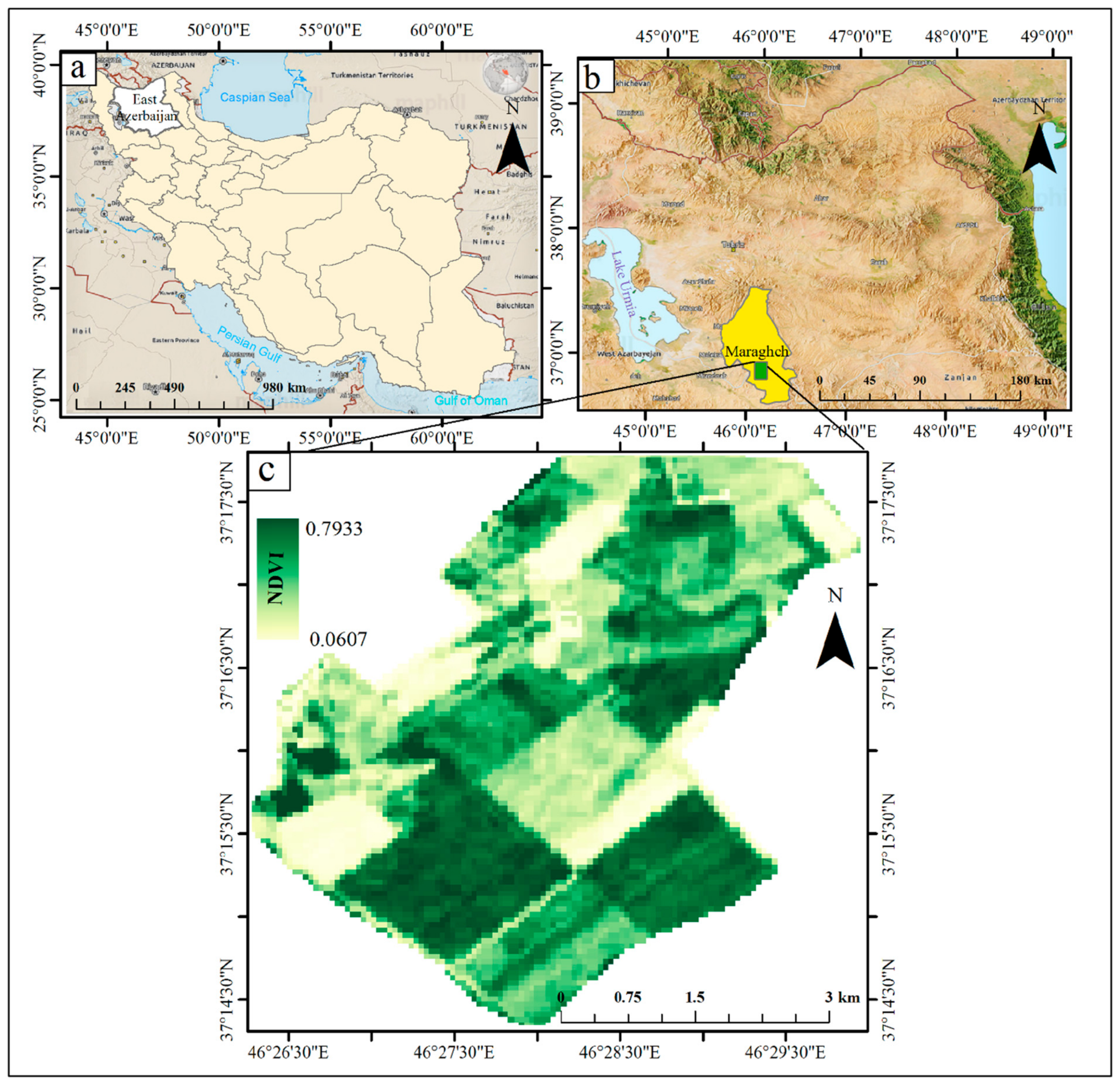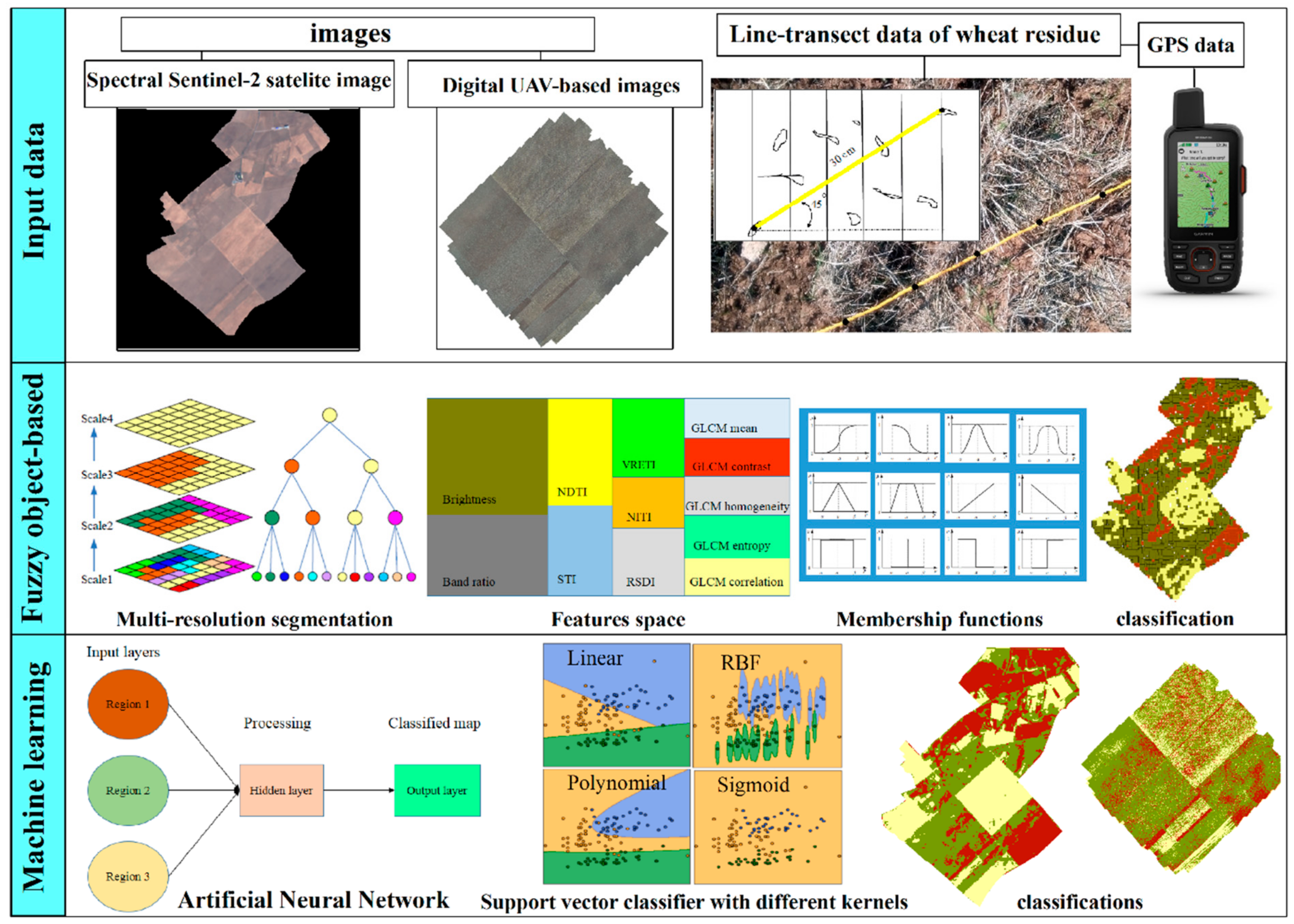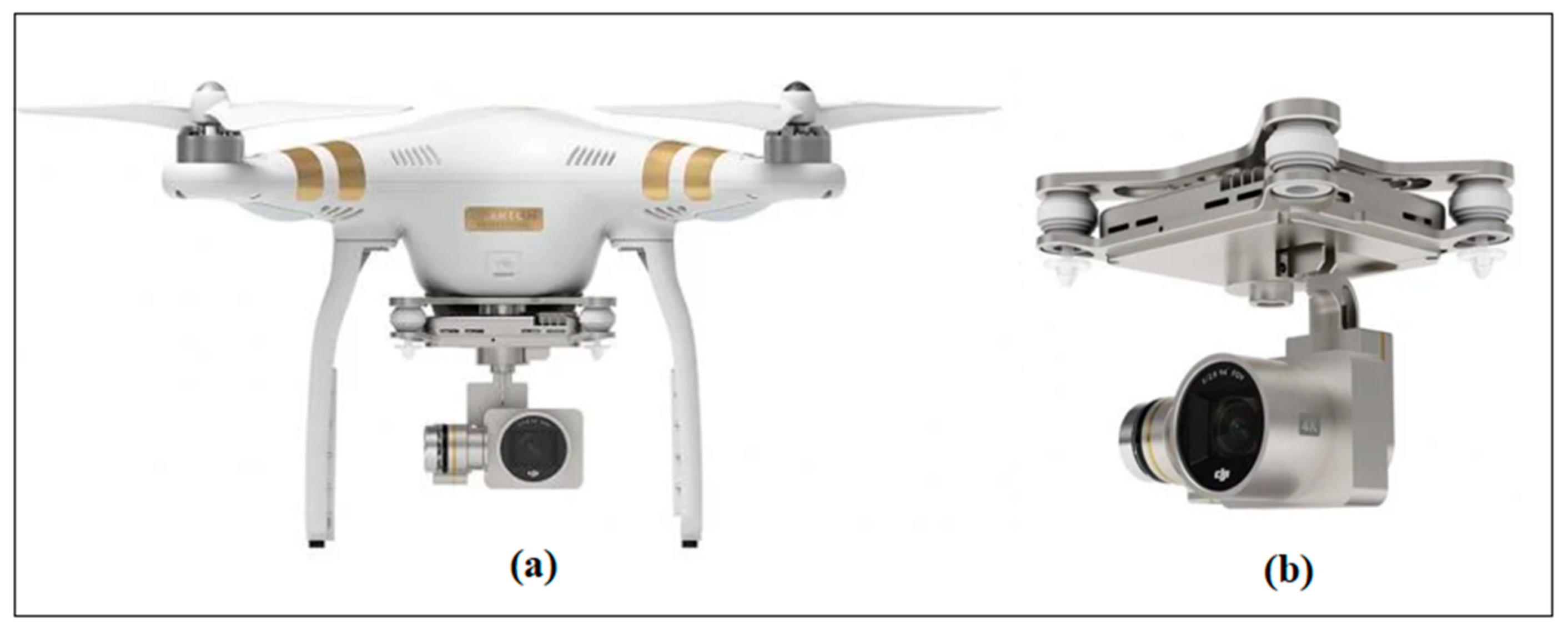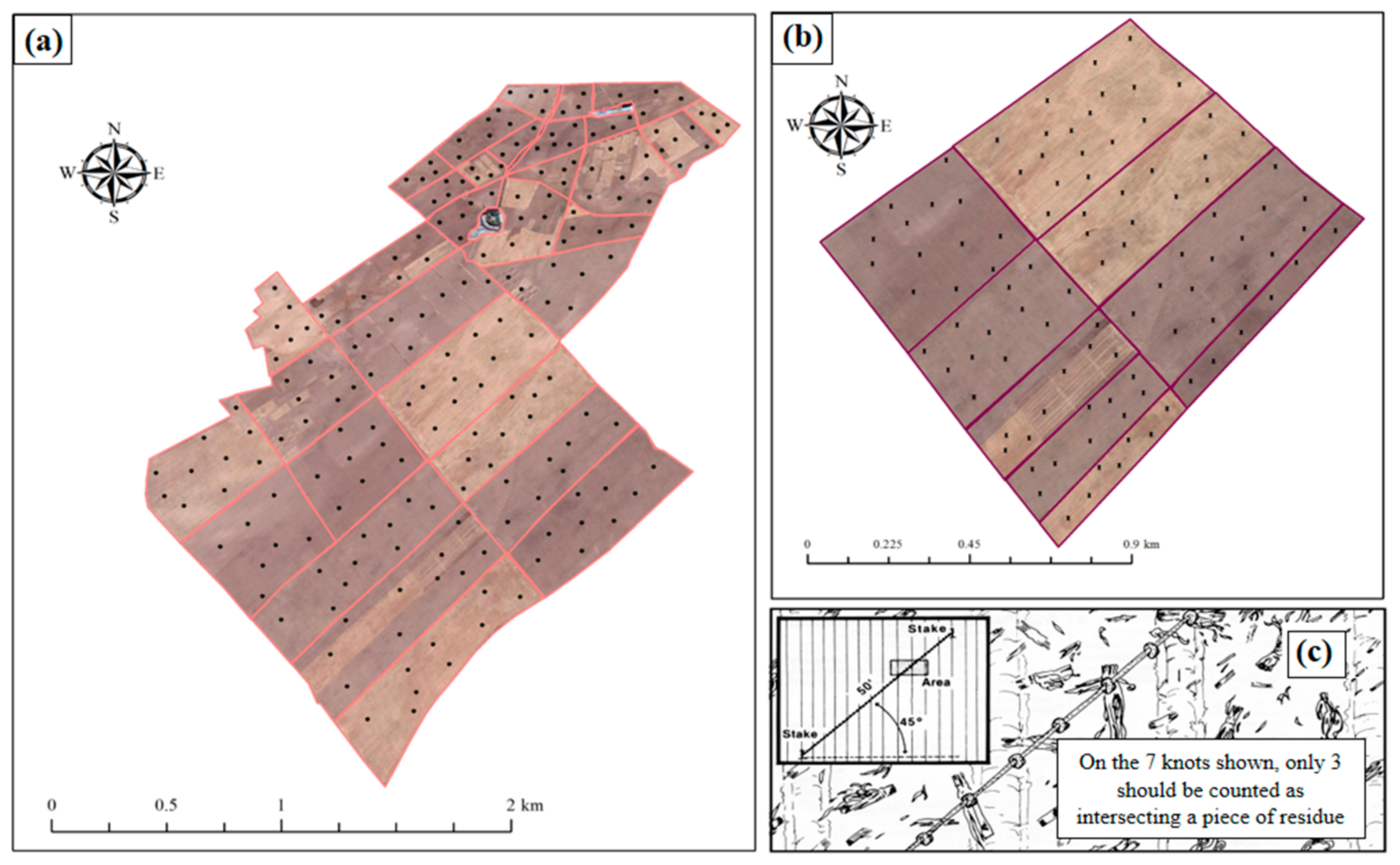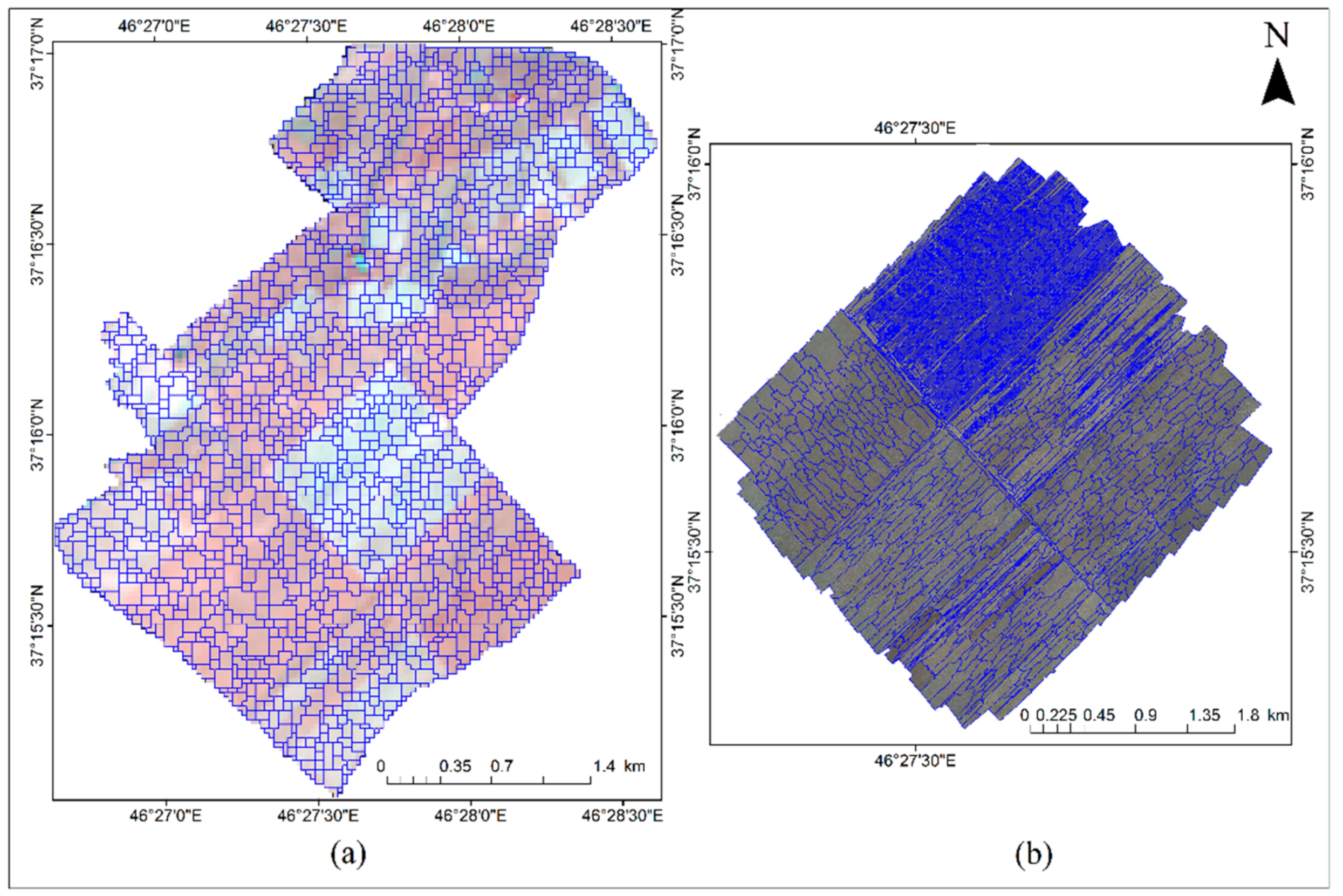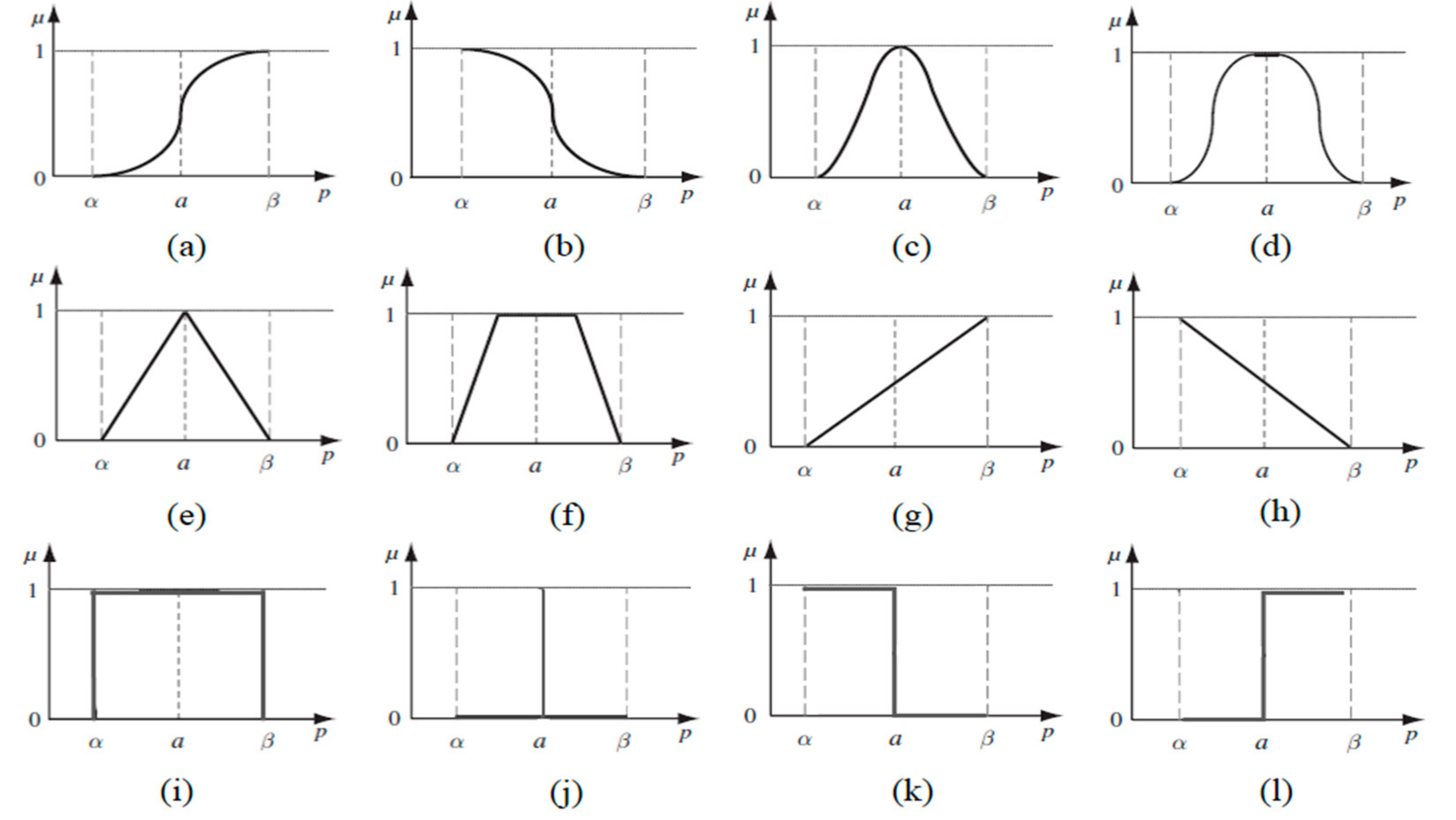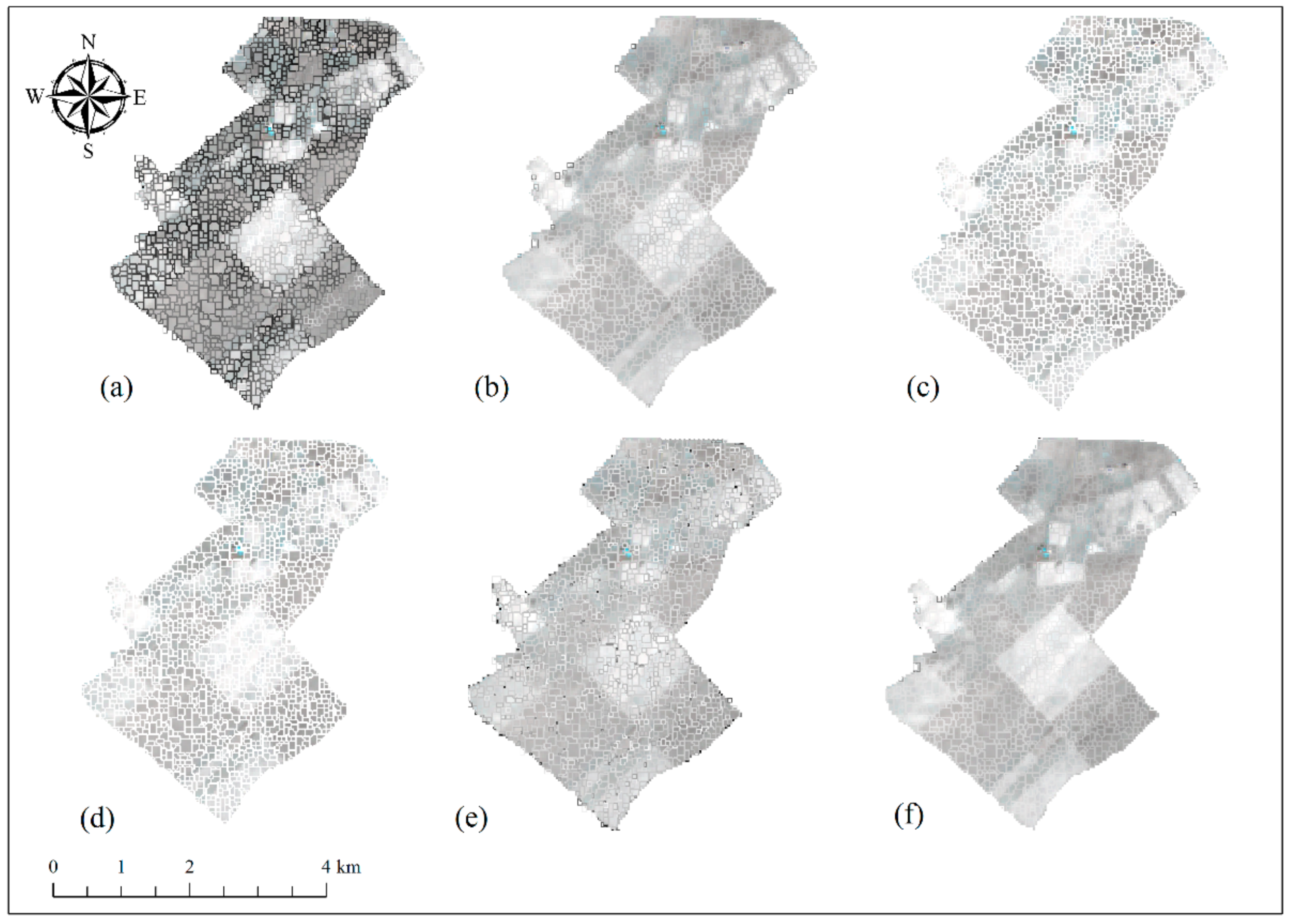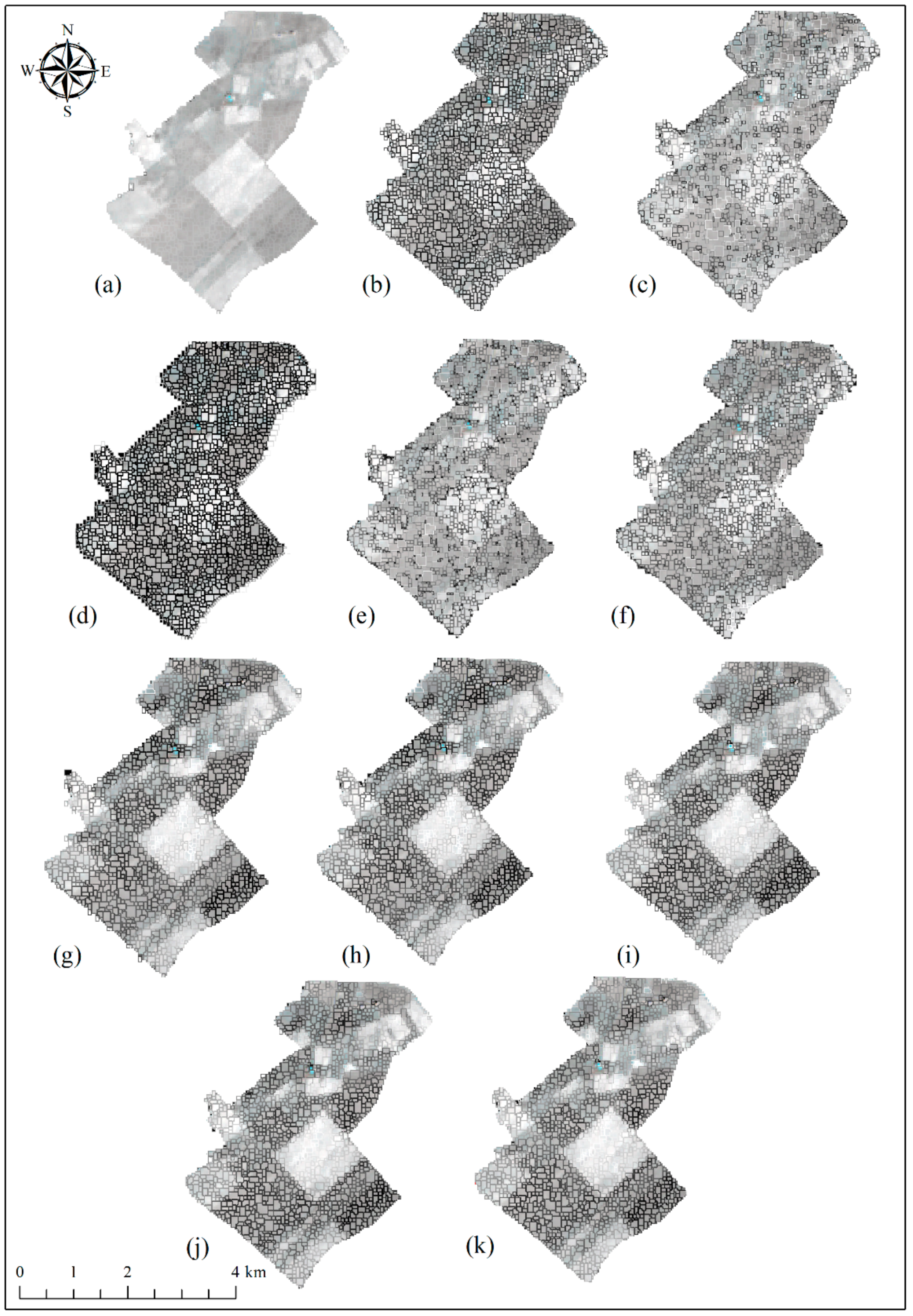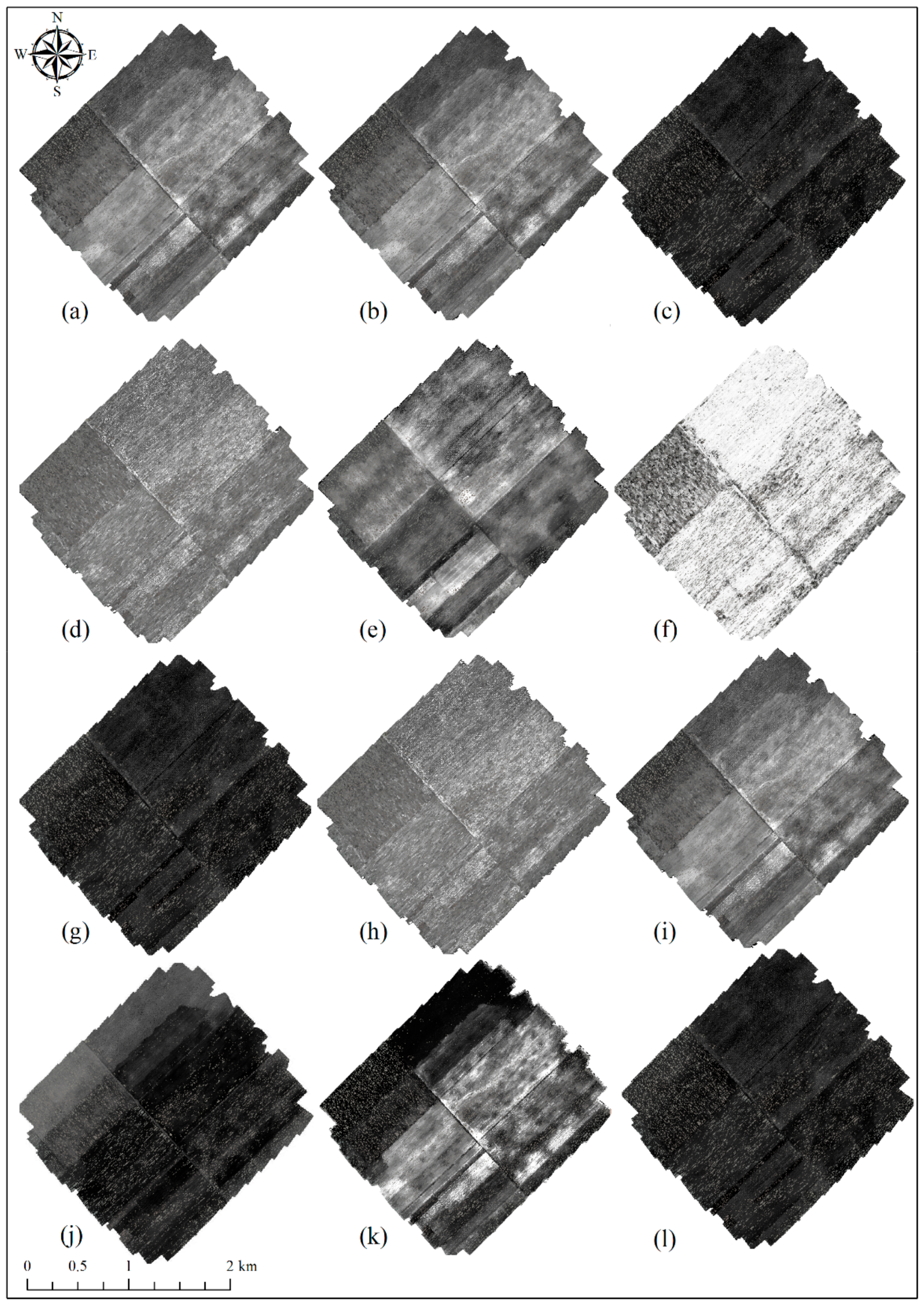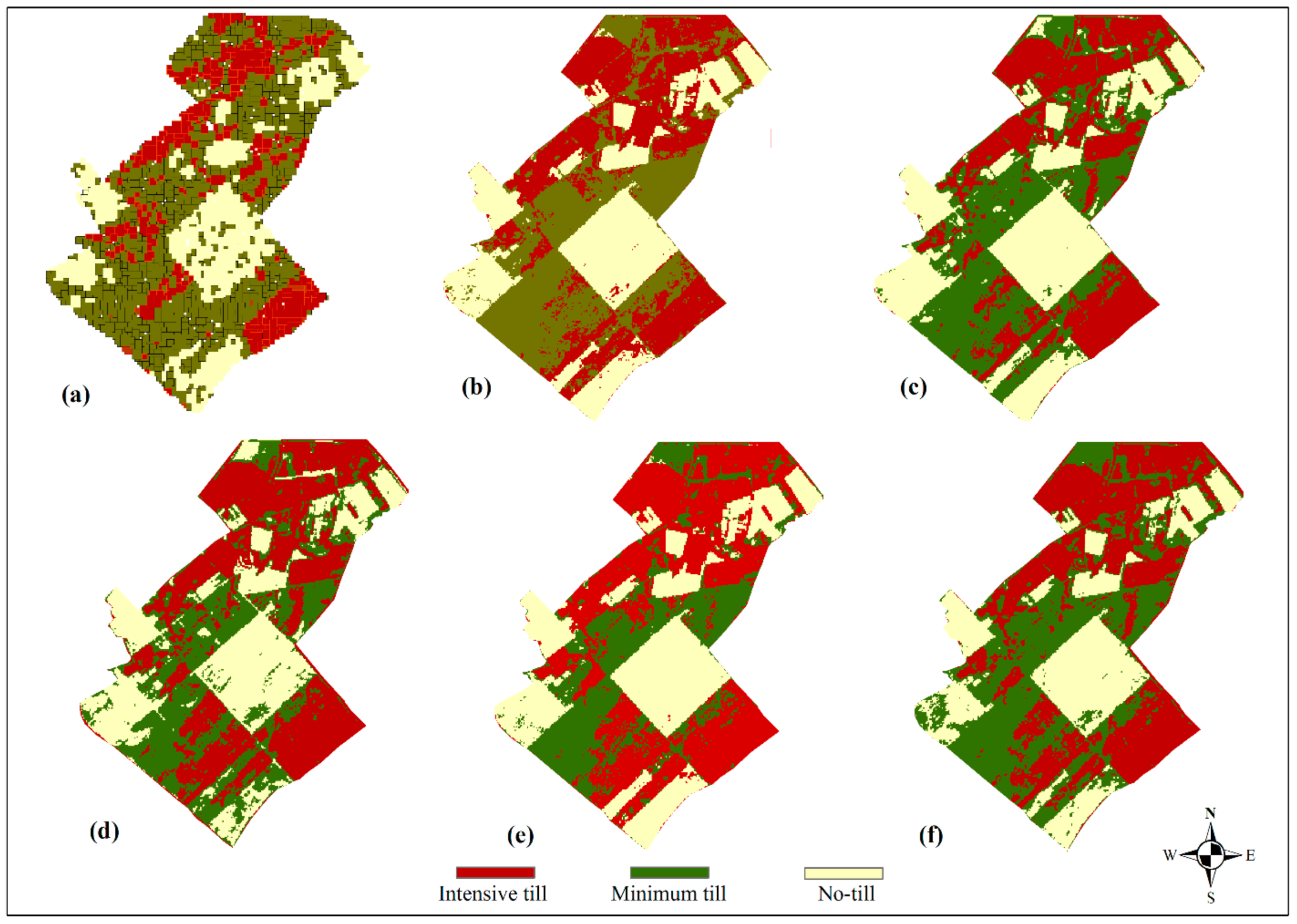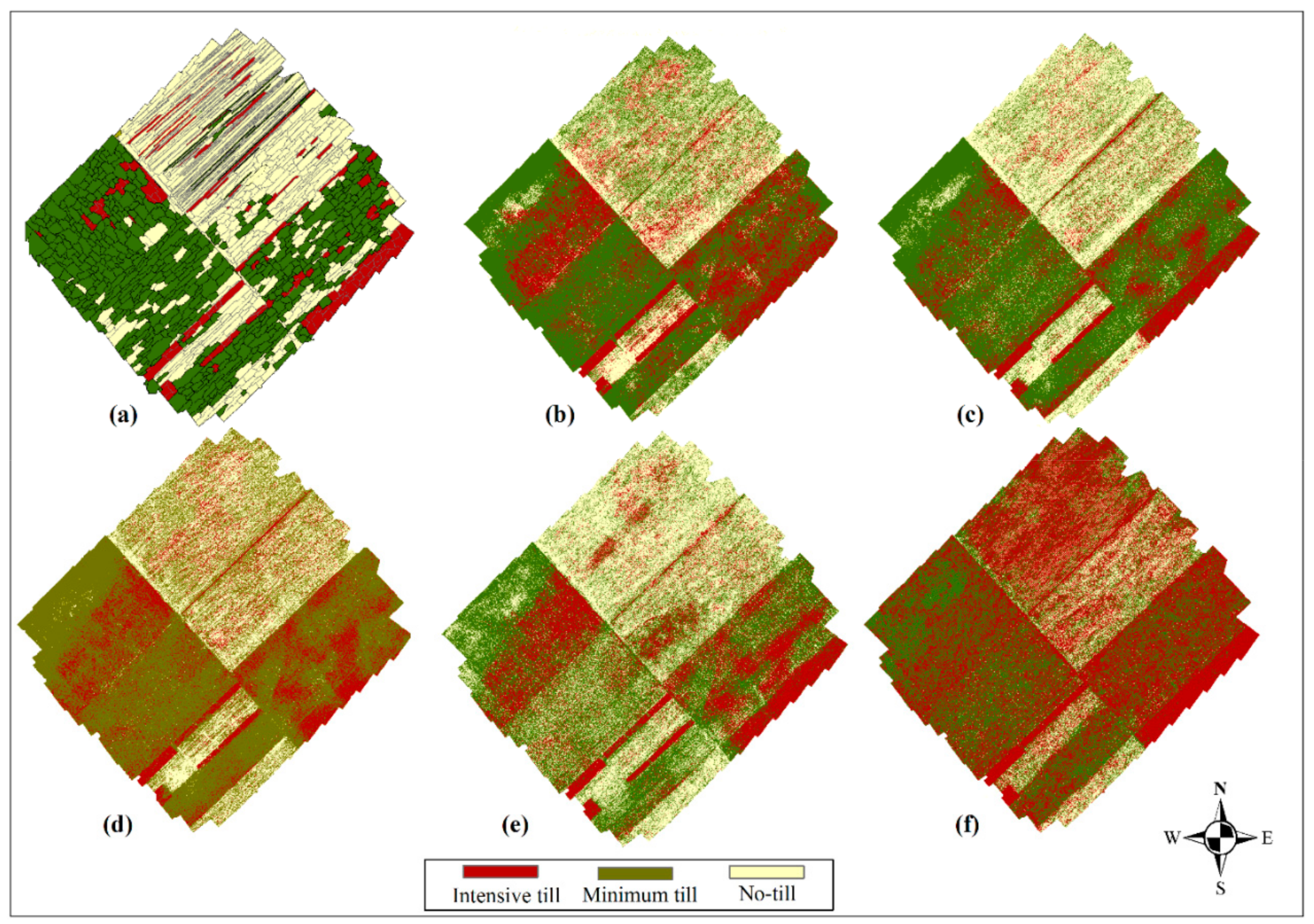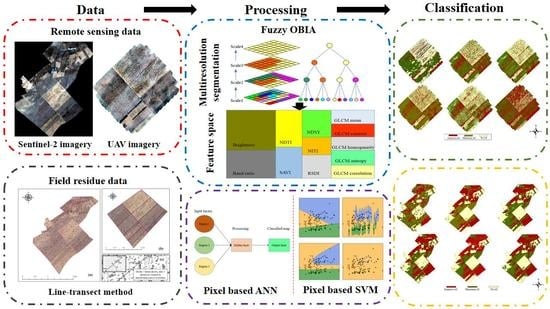1. Introduction
Soils as the critical part of the agricultural systems are providing about 98.8% of human food [
1]. Global population growth rate amounts to around 1.1 percent per year, and it is expected to reach from 7.8 billion in 2020 to 9.8 billion by 2050 and 11.2 billion by 2100 [
1]. This will pressure on the soils to increase food production by 70% to achieve global food security [
2]. However, excessive use of conventional agriculture methods have gradually degraded soil structures, reduced soil organic matter and increased soil erosions and nutrition loss. As a result, the loss of 15–26 Mt. of P and 23–42 Mt. of N from agricultural soils occurs annually and that nutrition has to be returned to the soils through fertilization [
3].
The use of intensive tillage equipment for field preparation practices simultaneously to the development of mechanization in the agriculture that stabilized conventional tillage methods in the farming systems. Although conventional tillage systems prepared a soft and free weed seed seedbed due to the intensive tillage practices that resulted in completely burying of the previous crop residue, these methods intensively have impacted the soil resources for decades [
4,
5]. As a result, intensive tillage methods led to drop in soil organic matter level and sped up the rate of soil erosion that finally led to sorely reduction in the soil fertility of the agricultural fields [
6,
7].
In recent years, efforts were carried out to present a clear view of the positive effects of the leaving crop residue on the soil surface for the both soil and crop conditions and its benefits for the agricultural ecosystems. Hence, those efforts led to the development of conservation agricultural systems across the world. Conservation tillage methods as the main part of conservation agriculture by maintaining a minimum amount of crop residue cover (CRC) on the soil surface protect it from the water and wind erosions, improve the soil organic matter that contributes to the sequestration of C in the soils and increase the water infiltration and storage that ultimately increase soil quality. Nowadays, the application of the conservation tillage systems seems to be essential in protecting the soil from the water and wind erosions [
8,
9,
10]. In this way, the crop residue from the previous cultivation is left out on the soil surface to shield soil particles against undesired climate conditions (e.g., heavy rainfalls, intensive evaporations, destructive winds and frosting) until crops are able to develop a protective canopy. It also significantly increases water efficiency in the cultivation of the cereal crops [
11].
According to the definitions of the conservation technology information center (CTIC), tillage intensity is identified as a critical factor for the classification of the conservation tillage methods [
12]. Hence, the coverage of at least 30% of the soil surface with previous crop residue after the tillage and planting practices is the main condition for every conservation tillage system [
13]. In general, the conservation systems vary from minimum to no-tillage. In no-tillage system, seeding is carried out directly into the standing stubble of the previous crops by using direct seeding planters [
14].
Despite a number of methods including photo comparison, meter-stick, computational methods and direct observation for estimation of the CRC, line-transect has been devised as a preferred method by Laften et al. [
15] for measuring the residue cover on the soil surface have obviously been advised by the natural resources conservation service (NRCS) [
16]. In contrast with high accuracy, this method is intensively time and labor consuming and implies unaffordable costs to the agricultural systems in vast areas [
17,
18,
19,
20].
Today, the application of remote sensing over extended agricultural areas is considered as a precise, inexpensive and quick solution to detect and map soil and crop conditions. The use of remote sensing in agriculture for monitoring and predicting crop conditions through fast analysis of large amount of data clearly restricts timeliness costs [
21,
22]. Although there are some cases of radar remote sensing [
23,
24], the majority of research studies have mostly focused on the utilization of the optical remote sensing methods for detecting and characterizing the CRC [
25,
26,
27,
28,
29,
30,
31,
32]. These methods exploit the absorption properties of the electromagnetic spectrum near 2100 nm which are caused by C-O and O-H bonds from lignin and cellulose and other saccharides in the external wall of the residue. These properties mainly distinguish the behavior of the crop residue spectral signature near 2100 nm from soil and vegetation [
33].
The use of tillage indices has widely been applied by researchers and developers for detecting the CRC in the three last decades. Reviewing the literature shows that the initial efforts for developing tillage indicators refer to McNarin and Portz [
34] with introduction of the two tillage indicators based on the mathematical relationships between Landsat thematic mapper (TM) bands of 5, 7 and 4. Although the current indicators represent a poor performance in separation of the previous crop residue spectral signature from soil and vegetation, it clearly was improved when van Deventer [
35] developed Normalized Difference Tillage Index (NDTI) and Simple Tillage Index (STI) based on the mathematical relation between the bands of 5 and 7 Landsat TM. Najafi et al. [
36] also made an advancement in the utilization of the tillage indices for detection of the CRC by introducing Sentinel-2 based indices. On the other hand, at the same time as launching hyperspectral sensors, many efforts took place to utilize the benefits of hundreds of narrow spectral bands of hyperspectral images. In this way, Doughtry et al. [
37] developed Cellulose Absorption Index (CAI) as a very capable indicator to make a clear contrast between crop residue, soil and vegetation signatures. It uses narrow spectral bands of 2030, 2210 and 2100 nm. The problem with hyperspectral images is that they are in demand and costly and cover small areas in comparison with periodically and free multispectral images that cover much extended areas.
Incorporation of the multispectral indices with the color, texture and shape factors of the agricultural features can significantly improve the detectability of the image analysis methods [
38,
39,
40,
41]. Jin et al. [
42] achieved promising results on the contribution of the textural features and the tillage indices for the detection of CRC and classification of the tillage intensity. The development of object based image analysis (OBIA) led to the consideration of different attributes of the resulting objects such as color, texture, geometry, topography and the brightness as well [
43]. Due to the development of the different remote sensing platforms in recent years and improvement in the spectral and spatial resolution of the remote sensing resources; it has become a big data. Hence, the study of this collection of data for different applications requires automated or semiautomated techniques to reduce the analysis time and cost.
The novelty of this study is investigation of the potential of semiautomated fuzzy OBIA in detection of the CRC and the classification of tillage intensity in comparison with two frequently used machine learning techniques of the support vector machine (SVM) and artificial neural network (ANN). Although there are plenty of studies that are concerned with the study of OBIA method for agricultural environments such as land cover classification [
44,
45], weed management [
46,
47] and crop yield estimation [
48,
49], a limited number of them are conducted to apply OBIA methods for estimation of CRC. Blaschke et al. [
50] investigated a number of publications that use OBIA approach and claim that this approach is an advanced paradigm in remote sensing. Kalantar et al. [
51] reported a superior performance of the fuzzy object based classifier in a comparative assessment with two pixel based classifiers of SVM and decision tree when classify land cover features. In the context of the estimation of CRC and tillage intensity using OBIA approach, Bauer and Strauss [
52] conducted a comparative assessment between manual analysis and semiautomated OBIA evaluation using eCognition for calculating crop residue and vegetation cover from RGB imagery. They reported that, while degree of agreement was approximately 0.75 for calculating residue cover using both the OBIA method and manual analysis, the time required for analysis was calculated at 15 min for automated image classification and 115 min for manual image classification, which this reduction in the required time for the image classification process was considered as a major advantage of the OBIA approach. Najafi et al. [
53] detected and classified CRC and tillage intensity using assign class OBIA classification method. Accordingly, more relevant thresholds of the three considered groups of spectral indices, vegetation indices and textural features obtained for the crop residue and applied in classification process. As a result of this study, object based brightness and NDTI indices demonstrated a great potential for replacement with their pixel based version. The use of image segmentation process in OBIA paradigm compared to pixel based approach has been changed from helping pixel labeling to object identification. A selection of optimal parameters of segmentation process is a key challenge for OBIA that can generalize image objects matching with the meaningful geographic objects [
54]. Najafi et al. [
36] conducted a comparative evaluation for between per-pixel regressions based approaches and a novel rule-based OBIA approach in order to the classification of CRC using multispectral Landsat operational land imager (OLI) satellite data. They concluded that the OBIA method clearly outperformed per-pixel regression based approaches in estimating CRC and also with the overall accuracy of 89% bear the potential to substitute ground-based techniques.
Although semiautomated OBIA methods demonstrated a great potential to detect and characterize CRC, the review of the literature has shown that machine learning pixel based methods also are very useful to distinguish crop residue from soil and green vegetation. In this context, Bocco et al. [
55] evaluated the CRC based on the machine learning ANN model by using Landsat TM and ETM+ images. Sudheer et al. [
56] also applied an ANN algorithm to estimate the CRC from Landsat TM image. They reported overall accuracies of 0.74–0.91 for different conditions. Based on the outcome of the earlier research, the main objectives of this study are: (a) to propose a novel methodology for the CRC monitoring by using a semiautomated fuzzy OBIA and as well as compering its efficiency against the two well-known pixel based machine learning techniques (SVM and ANN), and (b) to investigate the potential of unmanned aerial vehicle (UAV) based and satellite based imagery for detecting the CRC.
4. Discussion
Recent progress in remote sensing and earth observation technologies highlighted the significance of the automated/semiautomated methods as quick and effective data is driven the approach in the remote seining domain. Thus, development of the automated or semiautomated methods of evaluation is essential for the analysis of big data in remote sensing. In spite of the development of different remote sensing platforms with different spatial and spectral characteristics, the use of learning based methods for analysis of the input data is inevitable. By these means, we analyzed two types of imagery based on two different image analysis approaches of semiautomated fuzzy object-based and machine learning methods to detect the amount of the CRC left on the soil surface after the tillage and planting processes. It helps in identifying tillage intensity of applied practices during the seedbed preparation operations.
According to the literatures, fuzzy OBIA has a critical advantage over pixel-based methods of the image classification [
50,
54,
76]. It is the utilization of the spectral, textural, shape and size properties in addition to the brightness of the image objects in the classification process [
36,
40,
77]. We found that Tillage indices were a major part of utilized spectral properties in this study that improved the classification accuracy of fuzzy OBIA against two other methods. Based on the findings from Serbin et al. [
26] and Daughtry et al. [
27,
28] it was due to the absorption properties of the electromagnetic spectrum near 2100 nm which is caused by C-O and O-H bonds from lignin and cellulose and other saccharides in the external wall of the crop residue. This characteristic makes those instantly recognizable by using correspondence spectral indices NDTI and STI in which the area around 2100 nm is covered by spectral used bandwidths. Hence,
Figure 7 shows a clear contrast between the CRC and soil when applying NDTI and STI filters on the Sentinel-2 satellite image that also was in accordance with Najafi et al. [
53]. In contrast, the only factor for distinguishing image pixels in the two machine learning methods (SVM and ANN) was the brightness of image pixels.
We also observed that, in spite of the high spatial resolution of the RGB images from the UAV platform than the multispectral Sentinel-2 based image, accuracies are greater in the classification of the Sentinel-2 image when applying fuzzy OBIA method. It proves the effectiveness of the spectral tillage indices in the classification of the Sentinel-2 image by using fuzzy OBIA method. The RGB images due to the lack of NIR and SWIR bands are not able to use spectral indices in their feature space. Our finding is supported by the drawn results from García-Martínez et al [
91] who estimated canopy cover by using RGB and multispectral imagery.
As reported by Pan et al. [
49] on the formation of salt and pepper effects in pixel-based analysis of very high-resolution images we also observed this effect when applying the pixel based SVM and ANN methods of the image classification. It led to the formation of a heterogeneous mixture of different classes in each class in the final classification map. Thus, increasing this type of entropy in the field scale not only does not help in the interpretation of the results but also it leads to a confused final user. Segmentation process in the fuzzy OBIA method of the classification through the merge of adjacent pixels with similar characteristics and formation of image objects minimized those errors during classification.
Classification results of the application of the SVM and NN methods showed that Sentinel-2 image has slight superiority for assigning image pixels to the right classes in comparison with UAV. It was due to the fact that, in spite of the higher spatial resolution of the UAV image, soil background effects were considered as disturbance factors in the classification of the RGB orthoimage from UAV [
92]. It also observed that those effects reached to the highest value when applying the SVM classifier with linear kernel. In addition, the effects of mixing of pixels especially at class boundaries reduced classification accuracy.
One of the limitations with fuzzy OBIA was that this method needs experts with scientific and practical information about the relationship between the spectral properties and the CRC for the selection of correct features space [
71], but that information is unnecessary in the classification by using the SVM and ANN methods. This also could be a motivation factor for wide application of the fuzzy OBIA classification method for the evaluation of the CRC and tillage intensity to reach more accurate results. The efficiency of fuzzy OBIA has been recently addressed by researchers [
93,
94,
95,
96] while acknowledging the significance of this integrated approach as an optimized semiautomated object based classification technique.
5. Conclusions and Future Work
Conservation tillage methods through leaving the previous CRC on the soil surface protect it from water and wind erosions. Here we considered a comparative approach for a novel fuzzy OBIA method and common pixel-based machine learning methods for the estimation of the CRC from previous cultivated winter wheat after the tillage and planting practices. Applied remote sensing data in this study consisted of RGB images from UAV and multispectral images from Sentinel-2 satellite. Based on the results, we concluded that the fuzzy OBIA based on Gaussian membership function represented efficient results for the classification of the CRC. In spite of superior spatial resolution in RGB orthoimage from UAV, it is observed that overall classification accuracy for Sentinel-2 data surpassed the UAV images. For the multispectral Sentinel-2 image the combination include four features of band 12, NDTI, STI and GLCM correlation represented acceptable fuzzy numbers and maximized the classification accuracy across three classes of CRC. For the classification of UAV orthoimage the combination of the brightness, red, green, GLCM homogeneity and GLCM mean maximized the differences between soil and residue for the intensive tillage class. In addition, the features of blue, green, red and GLCM mean for minimum tillage class and Std.Dev of three bands of red, blue and green along with the brightness, GLCM contrast and GLCM homogeneity represented the highest classification accuracy. Implementation of SVM and ANN algorithms indicated that in spite of the capability of the SVM classifier with the RBF kernel and also the ANN classifier to the classification of different tillage methods based on the CRC, these methods are turned not to be as efficient as the fuzzy OBIA classifier for estimating the CRC. Based on the results of the current research, our future research will focus and apply an integrated approach of deep learning and fuzzy OBIA for monitoring the trend of the CRC and its impacts on conservation of soil. From the methodological perspective, it is widely known that the recent progress in remote sensing technology makes available satellite images with improved spectral and spatial properties. Thus, proposing and applying efficient and automated data of driven approach such as fuzzy OBIA or machine learning techniques (SVM, ANN) will support future researchers to identify the robust and weakness of each method. Based on this statement, the results of the current research can be considered as the progressive research in the domain of remote sensing science.
